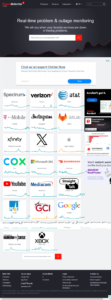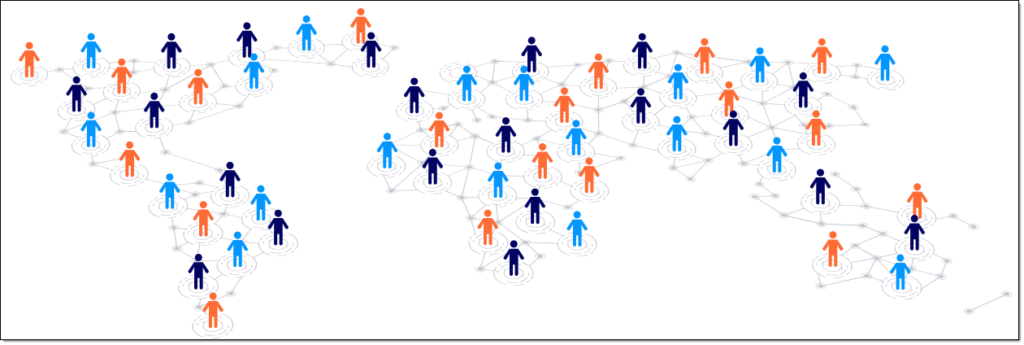With every webpage loaded, email sent, or video streamed, network traffic takes a complex journey…
The internet has become an essential part of our lives, especially when it comes to business. Whether for work, communication, or entertainment, we heavily rely on the internet’s availability. However, when the internet goes down unexpectedly, it can be frustrating and disruptive. This is where Downdetector has become integral for many people in determining the status of an internet service.
However, as most readers of this space know, with Exoprise there’s real-time monitoring and then there’s actual real-time monitoring.

Origin of Downdetector
Down detector, launched in 2012, was created to address the need for a reliable and centralized platform to report and track internet outages. Tom Sanders and Sanders van de Graaf developed the tool. By 2018, the service was acquired by Ookla (yes, the same company that brings you Speedtest.net) and monitors over 12,000 services internationally.
Starting as a simple website supporting only a few countries, Downdetector quickly gained popularity as a simple interface for reporting service issues and viewing detected outages. Over the years, it expanded its coverage to include regions across North America, Europe, Asia, and Australia, making it a common resource for individuals and businesses affected by internet disruptions.
Value of Downdetector
The primary value of Down detector lies in its ability to provide real-time information about internet service disruptions. By aggregating user reports and actively monitoring network availability, Down detector can accurately identify and display outage incidents. This information informs users whether an internet outage exists and is local or widespread, potentially saving them time and frustration in troubleshooting their own connections.
Down detector gathers information from:
- User reports about supported services, which are aggregated against historical problem reporting by location.
- Social media monitoring about problem reports regarding online services.
- Information gathered from the web about reported user experiences.
Downdetector’s user submitted reports, further enhance its detection capabilities and contribute to a more comprehensive picture of the outage landscape.
The popularity of Down detector lies in providing users the opportunity to see outage reports from other service providers and internet-based platforms. This comprehensive view of internet service disruptions enables users to identify patterns and trends about performance and status of service they use.
Additionally, they can learn about the historical performance of different providers, gain insights into service quality, and even compare the reliability of various internet service providers in their region. This information is potentially valuable for businesses relying on stable internet connections, as it aids in making informed decisions about internet service providers. News outlets can gain some insights into service status for reporting to the public.
Limitations of Downdetector
While Down detector is undoubtedly a useful tool, it also has its limitations.
- It heavily relies on user-generated reports, which may not always be accurate or timely. As users self-report outages, there is potential for misidentification or exaggeration of internet disruptions. Consequently, this may introduce instances of false positives or false negatives, where an outage is reported or missed, respectively. It is important to keep in mind that Downdetector’s accuracy is contingent upon the quantity and accuracy of user-generated reports.
- Down detector’s coverage varies by location and service provider. While it boasts extensive coverage in many regions, there are still areas where the tool may lack sufficient data to accurately track local outages. Users in these regions may find limited value from the tool or may need to rely on other means to identify internet service disruptions.
- Coverage may not include smaller or regional internet service providers, leaving users unable to access outage information for these providers.
- Down detector solely focuses on reporting and tracking internet outages. It does not provide explicit troubleshooting guidance or solutions for users experiencing connectivity issues. While its contribution lies in identifying the network disruption, users must exercise caution in relying solely on this tool for troubleshooting their own individual connection problems. In these cases, reaching out to their internet service provider or using additional troubleshooting resources may be necessary.
Additional shortcomings include:
- Usage of simple analytics rather than more in-depth internet troubleshooting.

- It’s a limited utility with limited functions, using little or no real-time monitoring methodologies.
- The nature of the outage is unknown.
- Estimated resolution is not indicated.
- It often relies heavily on information scoured from Twitter (X).
Alternative Internet Tracking
https://IsItDownRightNow.com and DownRightNow.com are two websites that provide users with more in-depth real-time information about the status of various online services and websites. These platforms play a crucial role in helping individuals and businesses determine whether a particular website is experiencing technical difficulties or if the problem is specific to their own internet connection.
IsItDownRightNow.com focuses on monitoring the status of popular websites and online services, including social media platforms, email providers, streaming services, and e-commerce websites.
DownRightNow.com takes a slightly different approach by providing a broader range of services to monitor, including online gaming platforms, cloud storage providers, and various online tools. The platform adopts a similar easy-to-use interface, promptly informing users about the status of a service through color-coded indicators. Additionally, it provides a comments section where users can share their own experiences or report issues with a particular service.
Both IsItDownRightNow.com and DownRightNow.com can be valuable resources for individual internet users and businesses. For individuals, these websites eliminate the ambiguity of not knowing whether a website is down or if the problem is with their own internet connection. This information empowers users to troubleshoot effectively and seek alternative methods for accessing the content or services they need.
From a business perspective, IsItDownRightNow.com and DownRightNow.com enable companies to:
- Understand where the real technical issues lie, instead of limited information from users or social media. Actionable data equals useful business decisions regarding finances and operational expectations during outages.
- Quickly identify if their own websites are experiencing technical difficulties that could potentially lead to a loss in customers or revenue.
- Stay informed about the status of third-party services, such as payment gateways or cloud storage providers, that they rely on for their daily operations.
- Proactively address any issues that may arise and minimize the impact on their operations and customer experience using access to real-time information.
The Power Of The Crowd
Although Down Detector is frequently used to verify the status of services, it is mostly tailored towards consumers rather than businesses. It sometimes takes a good amount of time to properly report an incident without many users reporting outages being experienced. Smaller, less used services and solutions may not even be reported to Down Detector in certain cases, rendering it useless in these situations.
Exoprise solutions, while proactively monitoring SaaS solutions, also anonymously aggregates all the collected statistics. The metrics are then sliced up by region, ISP, and ASN to expedite the detection and diagnosing of SaaS outages and performance problems. These aggregated data points are referred to as the “crowd” or crowdsourced.
These crowd-powered synthetics allow for easy and instant benchmarks as well as pointing out whether issues are yours or if everyone is being affected. When a service outage or performance issue occurs, it’s easy to identify if you, a region, or an entire service are being affected, allowing communication to be sent internally notifying users they may have a degraded experience.

Read more about the Exoprise Crowd
It’s all about Perspective, Network Perspective That Is
With Exoprise solutions, they install behind premises on virtual machine or on end-user devices behind the firewall so that you can detect last-mile issues in the network with Wi-Fi, gateways, Internet Service Providers, and more. Or even run Exoprise Service Watch on employee machines when they work remotely. Those last mile conditions and network variances are rarely reported by sites such as down detector – they just can’t be. That’s why Internet outage tracking sites are better for consumer oriented products than business-oriented products. Additionally, Internet outage reporting sites are ad-driven as opposed to paid business services.
Microsoft, itself, with its own service health indicators and reports, don’t provide any insight or perspective into the full end-to-end uptime of a business and its access to mission-critical services such as Microsoft 365 or Teams. There’s no perspective of the last mile with Microsoft 365 Service Health – there’s no help a business troubleshoot their network.
Conclusion
Downdetector has undoubtedly revolutionized the way we perceive and respond to internet service disruptions. With its information gathering, reporting, and outage tracking capabilities, it offers some data about internet outages. Valuable mainly for individuals and news organizations, this tool offers a basic view of network availability and historical outages.
However, Downdetector has its limitations, relying on user-generated reports and varying coverage across regions and service providers. Additionally, it does not provide resolution guidance or estimates. Lastly, its other limitations include limited technical analytics, no reporting on the nature of outages, and a heavy reliance on data gathered from social media.
IsItDownRightNow.com and DownRightNow.com provide invaluable services by offering more technical data in real-time about the status of websites and online services. Their easy-to-use interfaces and comprehensive coverage make them reliable and essential resources for individuals and businesses who rely on the internet for their daily activities. Both of these services are more suitable for businesses to determine if outages are affecting core functions, since their outage reporting is more geared toward technical rather than social analytics.


